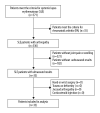Need for Greater Attention to Joint Damage in Rhupus Patients: Results from an Ultrasound Study
- PMID: 33112843
- PMCID: PMC7604975
- DOI: 10.12659/MSM.927104
Need for Greater Attention to Joint Damage in Rhupus Patients: Results from an Ultrasound Study
Abstract
BACKGROUND The aim of this study was to evaluate the prevalence of inflammation and bone destruction of hand joints in rhupus patients through ultrasound examination. MATERIAL AND METHODS Ten rhupus patients and 33 systemic lupus erythematosus (SLE) patients with hand arthropathy were recruited in this single-center study, and the clinical features and ultrasound manifestations of these patients were analyzed. RESULTS We discovered that rhupus patients were older (47.31±4.35 years vs. 38.58±2.50 years, P=0.040), had longer duration of disease (median 72 months vs. median 12 months, P=0.040), had a higher positive rate (70% vs. 10.71%, P<0.001), and had higher titers of anti-CCP antibody (42.633±14.520 vs. 2.121±0.970, P<0.001) than SLE patients with arthropathy. More importantly, the prevalence rates of synovial hyperplasia (90% vs. 42.42%, P=0.008), synovitis (90% vs. 18.18%, P<0.001), synovial hyperplasia (70% vs. 10.71%, P<0.001), and bone destruction (70% vs. 6.06%, P<0.001) were higher in rhupus patients than in SLE patients with arthropathy. CONCLUSIONS Rhupus patients are more prone to develop synovitis, synovial hyperplasia, and bone destruction. Therefore, more attention should be paid to protection of the joints in rhupus patients.
Conflict of interest statement
None.
Figures




Similar articles
-
Rhupus syndrome: assessment of its prevalence and its clinical and instrumental characteristics in a prospective cohort of 103 SLE patients.Autoimmun Rev. 2013 Feb;12(4):537-41. doi: 10.1016/j.autrev.2012.09.004. Epub 2012 Oct 11. Autoimmun Rev. 2013. PMID: 23063507
-
Comparison of ultrasonographic joint and tendon findings in hands between early, treatment-naïve patients with systemic lupus erythematosus and rheumatoid arthritis.Lupus. 2017 Jun;26(7):707-714. doi: 10.1177/0961203316676375. Epub 2016 Nov 12. Lupus. 2017. PMID: 27837198
-
Advancements in diagnosing stiffness and vascularization of synovitis in hands and wrists using shear wave elastography and power doppler ultrasound in patients with systemic lupus erythematosus.Eur J Radiol. 2025 Jun;187:112072. doi: 10.1016/j.ejrad.2025.112072. Epub 2025 Mar 29. Eur J Radiol. 2025. PMID: 40188633
-
Examining the clinical and radiological landscape of rhupus: navigating the challenges in disease classification.Rheumatol Int. 2024 Jul;44(7):1185-1196. doi: 10.1007/s00296-024-05561-0. Epub 2024 Mar 21. Rheumatol Int. 2024. PMID: 38512479 Review.
-
Erosive arthropathy: clinical variance in lupus erythematosus and association with anti-CCP case series and review of the literature.Clin Exp Rheumatol. 2007 Jan-Feb;25(1):47-53. Clin Exp Rheumatol. 2007. PMID: 17417990 Review.
Cited by
-
Case report: Joint deformity associated with systemic lupus erythematosus.Immun Inflamm Dis. 2022 Oct;10(10):e717. doi: 10.1002/iid3.717. Immun Inflamm Dis. 2022. PMID: 36169251 Free PMC article.
References
-
- Pipili C, Sfritzeri A, Cholongitas E. Deforming arthropathy in systemic lupus erythematosus. Eur J Intern Med. 2008;19(7):482–87. - PubMed
-
- Schur PH. Systemic lupus erythematosus. In: Beeson PB, McDermott W, editors. Cecil-Loeb Textbook of Medicine. Sanders; Philadelphia: 1971. p. 821.
-
- Tani C, D’Aniello D, Delle Sedie A, et al. Rhupus syndrome: Assessment of its prevalence and its clinical and instrumental characteristics in a prospective cohort of 103 SLE patients. Autoimmun Rev. 2013;12(4):537–41. - PubMed
MeSH terms
Supplementary concepts
LinkOut - more resources
Full Text Sources
Medical

